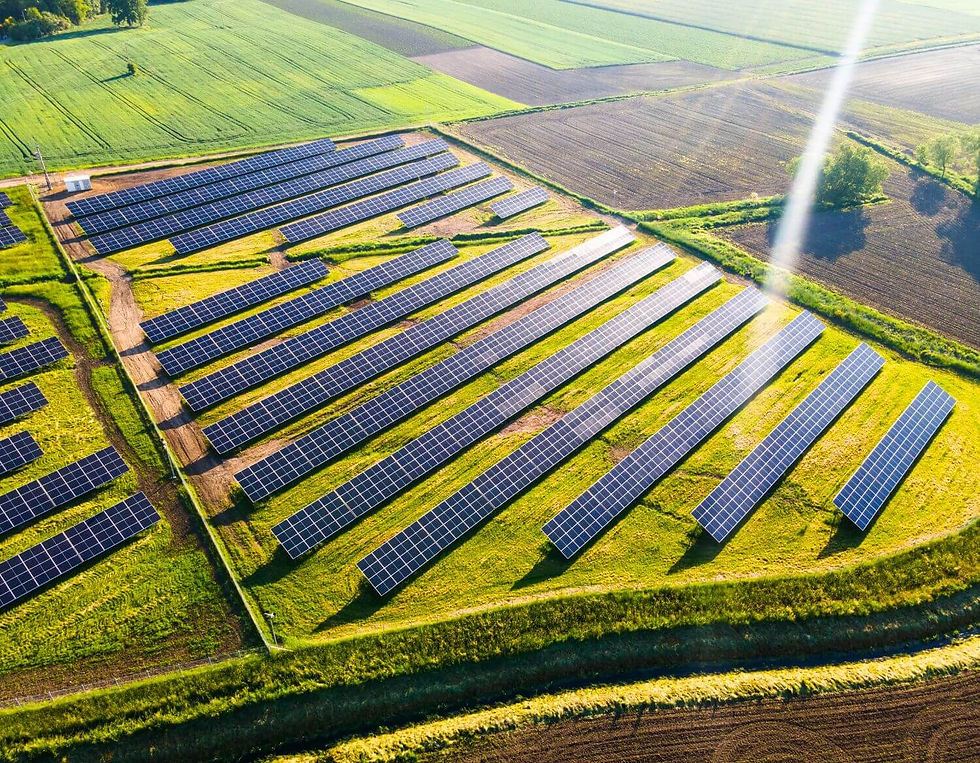Solar Beyond Rooftops – Flexible Panels, Solar Paint, and Integration into Urban Design
- Sankalp Agrawal

- May 10
- 3 min read
Solar power has long been a poster child for renewable energy, with rooftop panels dominating the visual landscape of sustainability. But as urbanization intensifies and the demand for renewable energy soars, innovation in solar technology is moving well beyond the traditional rooftop. From flexible solar panels and transparent photovoltaics to solar-integrated urban infrastructure and even solar paint, the possibilities are expanding rapidly—reshaping how we think about capturing the sun’s energy.
Beyond the Traditional Panel
Conventional rooftop solar panels are highly effective and continue to be a critical part of the renewable energy mix. However, they rely on ample space, optimal roof angles, and sufficient sunlight exposure—factors not always available in densely populated cities. In response, researchers and engineers have begun to develop solar technologies that can integrate more seamlessly into various aspects of the built environment.
One major advancement is flexible solar panels made from thin-film photovoltaic materials such as perovskite or organic solar cells. These panels are lightweight, bendable, and can be installed on curved surfaces, vehicles, clothing, or portable devices. Unlike traditional silicon panels, they can be manufactured using roll-to-roll processes, making them potentially cheaper and easier to deploy at scale.

Introducing Solar Paint and Transparent PV
Among the most futuristic innovations in the solar space is solar paint—a photovoltaic material applied like conventional paint, capable of converting sunlight into electricity. While still in the early stages of development, prototypes such as hydrogen-producing solar paint developed by RMIT University in Australia show great promise. These materials work by absorbing moisture and sunlight, splitting water molecules to generate hydrogen fuel. If commercialized, solar paint could turn virtually any surface into an energy-harvesting structure.
Transparent solar panels, or photovoltaic glass, represent another leap in design. These are windows or glass facades embedded with photovoltaic materials that generate electricity while still allowing light to pass through. Such panels are already being tested in buildings, greenhouses, and even smartphones. They offer a unique dual functionality—providing both natural light and power generation—ideal for high-rise urban architecture.
Solar in Urban Infrastructure
Cities are now exploring ways to integrate solar technology directly into urban infrastructure. Solar-powered streetlights, benches, bus stops, and even sidewalks are emerging as practical, visible examples of how renewable energy can be embedded in daily life. These installations not only generate power but also enhance the aesthetic and environmental appeal of urban spaces.
Architects and planners are adopting building-integrated photovoltaics (BIPV)—materials that replace conventional building elements like roof tiles, facades, or skylights with solar-capable components. The Tesla Solar Roof is a notable example, blending the look of traditional roofing with solar functionality. Such designs ensure that energy harvesting becomes an invisible, yet intrinsic, part of modern architecture.
Benefits Beyond Energy Generation
The new generation of solar technologies isn't just about electricity; it’s about resilience, decentralization, and accessibility. Flexible and integrated solar solutions can provide energy in locations where grid infrastructure is weak or nonexistent. For instance, solar fabric tents are used in disaster relief efforts to supply power for lighting, communication, and medical equipment.
On a broader scale, urban solar integration helps reduce the heat island effect—a phenomenon where cities become significantly warmer than surrounding rural areas due to heat-absorbing materials. Solar roofs and facades reflect or absorb less heat compared to traditional materials, improving overall thermal comfort in dense environments.

Challenges and the Road Ahead
Despite the excitement, several challenges remain. Flexible and transparent solar technologies still lag behind silicon-based panels in terms of efficiency and lifespan. Research is ongoing to improve their durability and make them more cost-competitive. Standardization and certification are also needed to ensure safe and effective deployment, especially in building-integrated applications.
Moreover, integrating solar into urban planning requires collaboration between engineers, architects, policymakers, and developers. Regulatory frameworks must evolve to support innovative solar adoption while ensuring aesthetic harmony and structural safety.
Nevertheless, the momentum is undeniable. As climate concerns rise and energy needs increase, the demand for invisible, integrated, and intelligent solar solutions is growing. With continued investment and research, these emerging solar technologies will play a crucial role in making cities more sustainable, self-sufficient, and future-ready.
A Solar-Powered Vision of the Future
Solar energy is no longer confined to rooftops. It’s becoming embedded in the very fabric of our urban environments—from walls and windows to benches and buses. This shift not only expands the reach of solar power but also redefines the relationship between technology, architecture, and nature.
As we move toward smarter and greener cities, embracing a broader vision of solar integration is essential. Whether through paint, glass, or flexible films, every surface can become a power plant—quietly generating clean energy while supporting a more sustainable way of life.






Comments